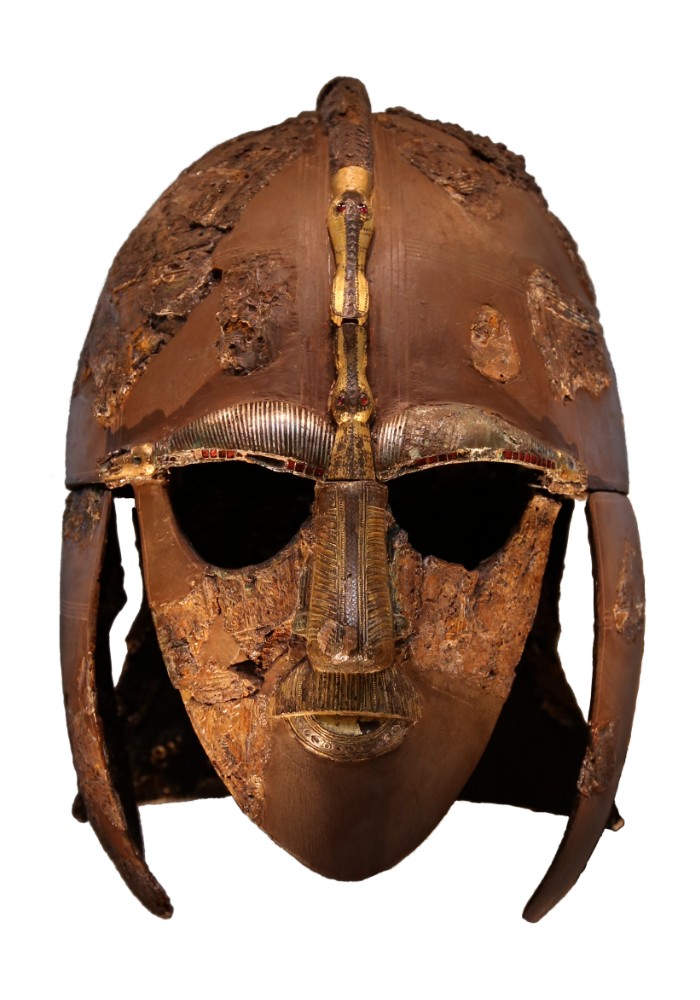“I am called Mask, I am called Wanderer,
Warrior and Helm-wearer,
Known and Third, Thund and Ud,
Hellblind and High…”
– Grímnismál
The above quote, from which this article takes its name, is a rather enigmatic verse spoken by Odin in the Old Norse Eddic poem Grímnismál. The poem is a recounting of an episode in which the god Odin, in disguise as a man called Grimnir, narrates to the human king Geirrod how the worlds of the gods are delineated, what creatures live in those worlds, and other arcane knowledge pertaining to how the cosmos are structured. At the end of this episode, Odin reveals his true identity to Geirrod, first referring to himself first through a list of names including “Mask”, and “Masked One” (Grimnir itself also means Masked One), before finally stating that he is in fact the god Odin.
While it is difficult to say for sure what Odin means in the episode detailed above when referring to himself as “Mask” or “the Masked One”, we can almost certainly say that it was somehow related to the practice of magic or sorcery that the god is often associated with. Masks have long been known to be utilized by many cultures around the world in various types of ritual performance. Often this involves the communication of esoteric knowledge, or the transformation of the individual wearing the mask into an animal or mythical being. The peoples of Iron Age Scandinavia and northern Europe were likely not strangers to these practices. Masks and masked figures can be found in art of various mediums, be it on runestones such as the famous DR-66 ‘Mask’ stone from Aarhus, Denmark, woven art like the Oseberg tapestry, in which several figures appear to be wearing animal masks, or in assorted types of metalwork, from gold foils depicting figures with mask-like animal faces, to forms of jewelry featuring human-like masks. Actual masks made of felt meant to depict some forms of animal have even been found at the Viking Age settlement of Hedeby, as well as in Novgorod. Furthermore, there are several more indirect references to masking in the Icelandic sagas; one in which a religious figure known as a völva veils her face whilst appearing in a dream; and another in which a man covers his head for the purpose of meditation. At least one such face-covering is known in the archaeological record from the grave of a possible völva at Fyrkat in Denmark.
All of the above is to say that masks were a known concept in Northern Europe, perhaps even for the practice of ritual.
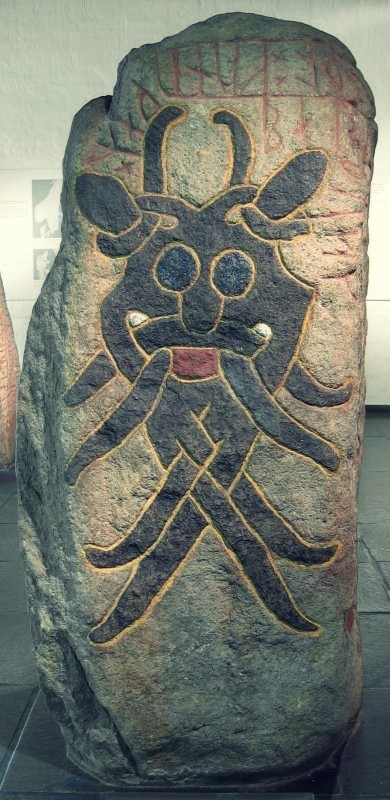
Another type of mask? Helmets of the Vendel Period
The famous helmets of the Vendel period (approximately AD 550 to AD 750), immediately preceding the Viking Age (approximately AD 750 to 1100), have long been seen as a marker of the elite authority present in Northern Europe at the time. These helmets include those from the boat graves at Vendel, Valsgärde, Ulltuna, and Tuna in Sweden, as well as those from other parts of Northern Europe. These would include many contemporary helmets from Britain, most notably the Sutton Hoo helmet. Similar patterns in cultural practices and material culture, helmets included, have long indicated close ties between the Anglo-Saxon groups of Britain and contemporary groups in Scandinavia. Though each example can be highly variable in terms of appearance, all of the helmets can broadly be said to follow a similar structural pattern; an iron bowl to cover the cranium; a ridge or crest on top of the bowl, often containing zoomorphic patterns; a facial covering typically containing zoomorphic patterns as well as facial features such as eyebrows above the eyeholes (also known as oculars); and finally, many have some form of pressed gold foils along the sides of bowl, typically depicting various scenes involving humans (some wearing masks) or animals. Individual variations include the chainmail ‘curtain’ around the bottom of the helmet from the Valsgärde 8 boat grave and the simulated facial hair on the Sutton Hoo helmet.
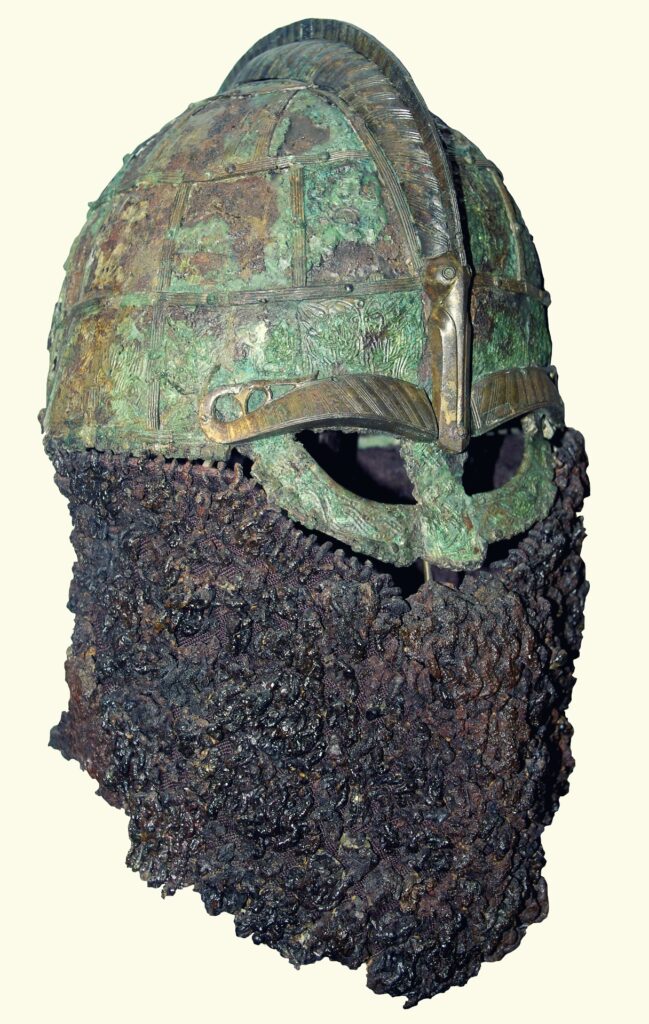
It is important to note that the helmets were very much statement pieces, meant to be seen far and wide. They are lavishly decorated in all manner of nonferrous precious metals, including gold, silver, and bronze, with rich and complex patterns of zoomorphic art. Many are also ornamented with cloisonné patterns, a type of decoration involving the placement of (in this case) garnets within cells of metal wire and backed by gold foil. They are typically found only within the most richly adorned boat graves, containing all manner of elite warrior accoutrements, including heavily ornamented swords, shields, spears, as well as other less martial trappings of wealth. Archaeologists has noted their similarity not with contemporary helmets from other regions of Europe, but rather with late Roman (2nd to 6th century) parade helmets, particularly those associated with the house of the emperor. It is also suggested that the rather delicate nature of the objects might imply that they were not meant to serve as protection at all, being more for the purpose of display and show.
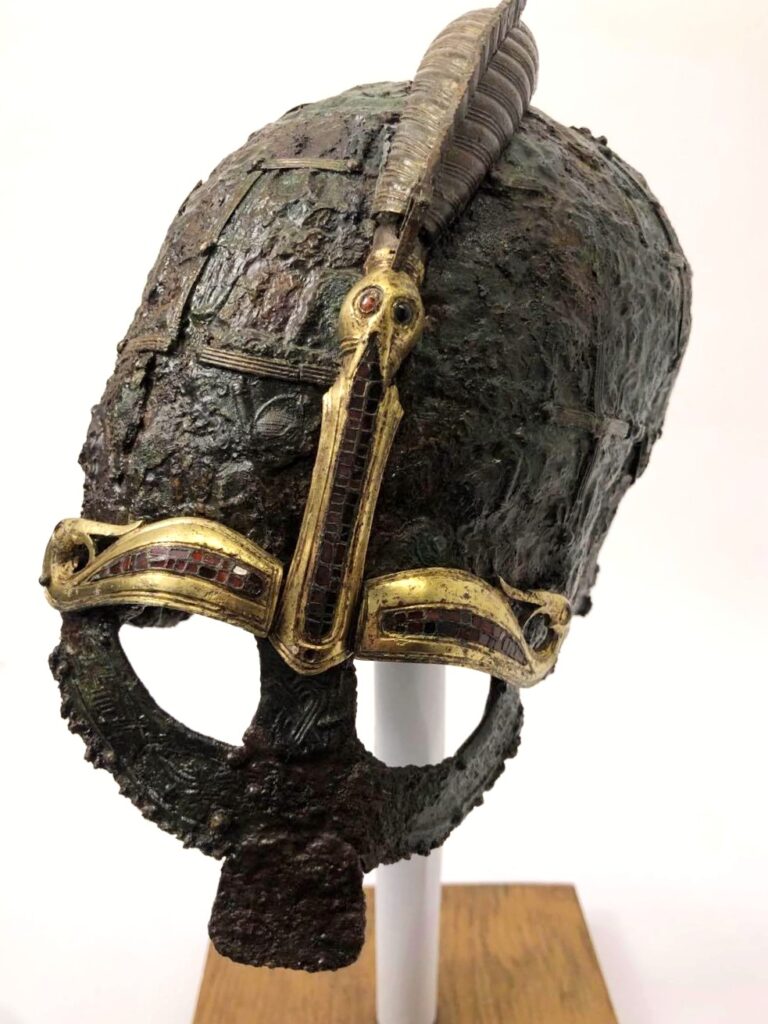
Given the richly adorned nature of the helmets, their similarity to Roman parade helmets, the imagery that appears on them, and the contexts in which they are found, it seems reasonable to suggest that these were certainly meant to be symbols of power and prestige. However, recent research on the ocular structures suggests that these helmets were perhaps designed to also fulfill a function not dissimilar to the way in which many cultures use masks: in rituals of performance and transformation.
Enter the ocular: helmets as performative objects?
There is no doubt that the ocular structures would have been a focal point of the of the object. They are heavily stylized with false ‘eyebrows’ of precious metals and garnets, and in most cases would have been the only area of the helmet where one could see the wearer beneath. A recent study of these structures by archaeology professor Neil Price and researcher Paul Mortimer on the Sutton Hoo helmet has demonstrated a discrepancy between the two eyebrows themselves, specifically in their cloisonné work. Typically, cloisonné work of the Vendel Period in northern Europe involved three components; cells made of some form of nonferrous wire, garnets set within these cells, and a thin foil of silver or gold set behind the garnets within the cells in order to allow them to reflect light more effectively. This is where our discrepancy comes in: only one of the eyebrows contains this gold foil backing the garnet, meaning that only one eyebrow would have reflected light. Past analyses of this inconsistency have largely interpreted as a repair, or a mistake. In other words, not intentional.
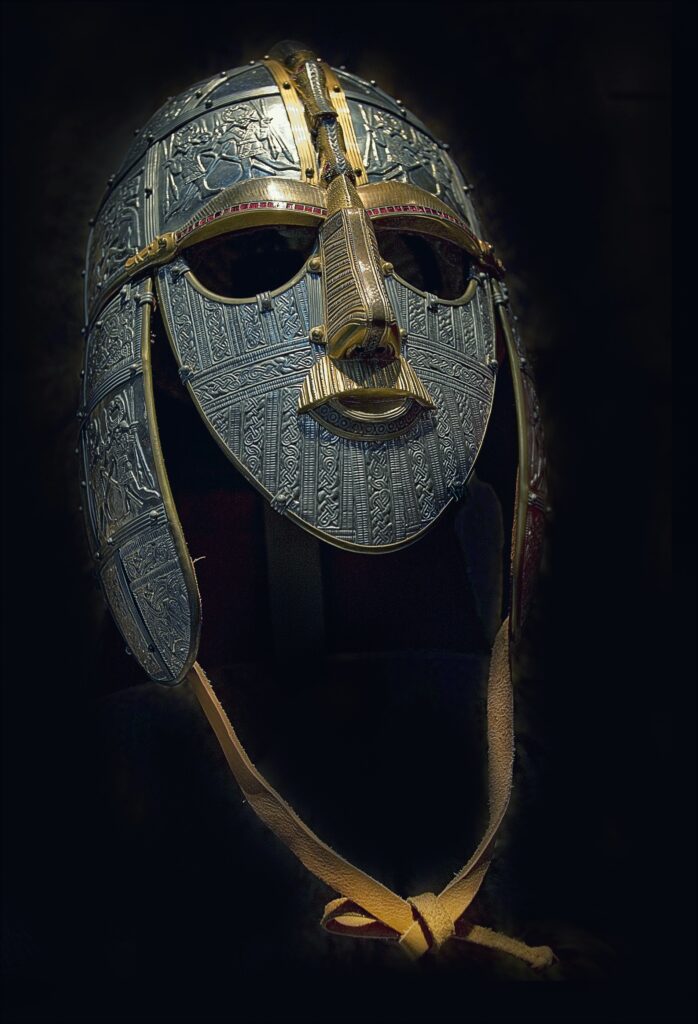
Price and Mortimer, on the other hand, offer a different explanation, stating that this may have been an intentional design feature of the helmet, in order to make the wearer appear as one-eyed. That there is a large precedent for this feature to be intentional is undeniable. Animals on the crest of the Sutton Hoo helmet, and at least one of the helmets from Valsgärde also appear as one-eyed through the lack of a foil in one eye, and there is a large body of other material culture stretching from the Migration Period through to the Viking Age that feature one-eyed figures. These include statuettes and art on various pieces of metalwork from buckles to pendants, depicting both animals and humans with one eye struck out or otherwise removed. A more striking example is a late 2nd century Roman parade helmet that had been taken from the empire itself all the way to Hellvi, Gotland, Sweden, where it was modified to have only one eye. Furthermore, it is suggested by Price and Mortimer that it actually may have been hanging on a post in the building in which it was found, based on the excavation evidence. So here we have an actual Roman parade helmet, rather than an imitation, also taking on this one-eyed appearance. Perhaps most interestingly, a number of disembodied helmet oculars have been found to have been intentionally removed from helmets and intentionally deposited. Thus, we have a remarkable and rather variable pattern in the material culture of the period emphasizing the significance of a single eye.
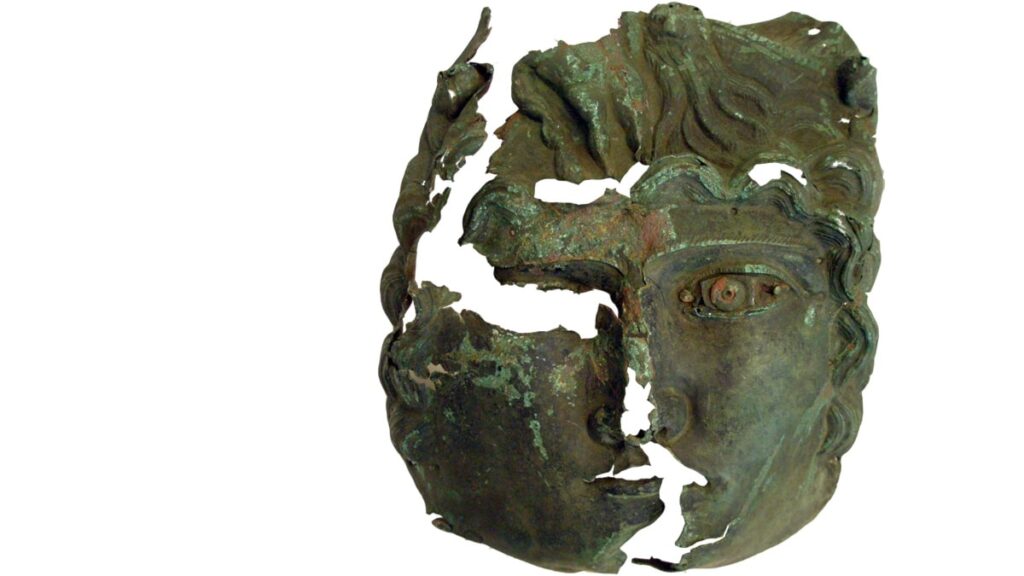
The helmet as a whole in its proper context
So why one eye? The obvious answer here is that this was a reference to Odin, specifically a particular episode in his quest for knowledge in which he travels to the base of world tree Yggdrasil, where there is located a well whose waters contain all the knowledge of the cosmos. In order to drink from the well and attain this knowledge, Odin must offer up one of his eyes to the keeper of the well, a being called Mímir.
Odin symbolism would certainly have made a powerful statement on the helmet of an elite figure. Odin is primarily associated with knowledge and the military elite in pre-Christian Scandinavia. Notably, he is the king of the Norse pantheon, and traveled between the worlds in an all-consuming quest for knowledge, often going through great pains to attain it (see the episode recounted above). Obviously, knowledge and sacrifice would have been admirable and desirable concepts to be associated with as a ruler, but is there more going on here than mere symbolism? Price and Mortimer argue yes: to round off their analysis of the Sutton Hoo oculars, a replica of the original helmet was placed in a reconstruction of a Vendel Period hall under the same lighting conditions that would have been present at the time. The effect produced is a single glittering eye in the murk of the dimly lit hall.
The stark image recreated in the experiment detailed above speaks to something more than symbolism. It speaks to a transformation of the wearer, perhaps even embodying the god Odin himself, similar to many ethnographic accounts of mask transformation from around the world. Given Odin’s propensity for magic and traveling across worlds, it is not unrealistic to think that perhaps the peoples of pre-Christian Scandinavia saw Odin himself behind the mask under certain conditions, not in a symbolic sense, but a literal sense.
Given their overall appearance as helmets, we cannot say with absolute certainty that these objects were not meant to serve as protective headgear in some fashion. However, it is clear from the case study above that this may not be all they were meant to be. With masking practices a known concept in pre-Christian Scandinavia, we might consider these helmets to be apart of an elite practice of masking and transformation.
Cover Photo: The fragments from the Sutton Hoo helmet, England. Photo: Wikipedia
Text: Derek Parrott 2021. Copyright 2021 Scandinavian Archaeology.
Translation of Grímnismál poem: Larrington, 2014.
Further Reading:
Price and Mortimer 2014
Price, N. and Mortimer, P., 2014. An Eye for Odin? Divine Role-Playing in the Age of Sutton Hoo. European Journal of Archaeology, 17(3), pp.517-538.
Masks and Masking Practices
Pollock, D., 1995. Masks and the semiotics of identity. The Journal of the Royal Anthropological Institute, 1(3), pp.581-597.
Migration Period Helmets and Mask Symbolism
Back Danielsson, I., 2010. Sense and Sensibility: Masking Practices in Late Iron Age Boat-Graves. In: F. Fahlander and A. Kjellström, ed., Making Sense of Things: Archaeologies of Sensory Perception. Stockholm: Stockholm University, pp.121-140.
Valsgarde
Norr, S., 2008. Valsgärde studies: The Place and its People, Past and Present. Uppsala: Department of Archaeology and ancient History, Uppsala University.
Sutton Hoo
Carver, M., 1998. Sutton Hoo: burial ground of kings? London: British Museum Press.
About the author

